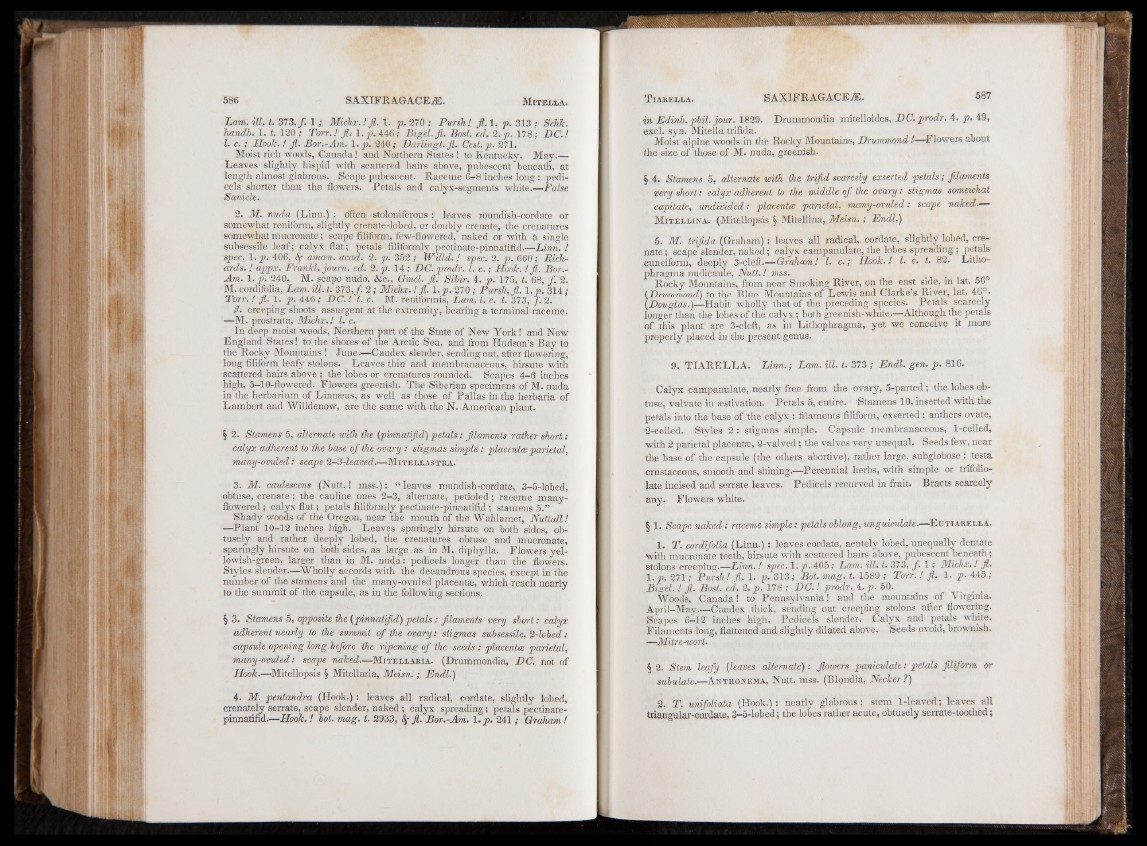
Lam. ill. t. 373,/. 1 ; Michx..'ft. 1. p. 270 ; Pursh! ft. 1. p. 313 ; Schk.
handb. 1. t. 120 ,• To n.! ft. 1. p. 446 ; Bigel. ft. Bost. ed. 2 .p. 178; DC.!
1. c .; Hook. ! ft. Bor.-Am. 1. p. 240 ; Darlingt. ft. Cest. p. 271.
Moist rich woods, Canada! and Northern States ! to Kentucky. May.—
Leaves slightly hispid with scattered hairs above, pubescent beneath, at
length almost glabrous. Scape pubescent. Raceme 6-8 inches long : pedicels
shorter than the flowers. Petals and calyx-segments white.—False
Sanicle.
2. M. nuda (Linn.) : often stoloniferous ; leaves roundish-cordate or
somewhat reniform, slightly crenate-lobed, or doubly crenate, the crenatures
somewhat mucronate; scape filiform, few-flowered, naked or with a single
subsessile leaf; calyx flat; petals filiformly pectinate-pinnatifid.—Lin n .!
spec. 1. p. 406, tif amcen. acad. 2. p. 352 ; Willd.! spec. 2. p. 660; Richards.
! appx. Frankl. joum. ed. 2. p. 14; DC. prodr. 1. c .; Hook. ! ft. Bor.-
Am. l.p . 240. M. scapo nudo, See., Chnel. ft. Sibir. 4. p. 175, t. 68, f. 2.
M. cordifolia, Lam. ill. t. 373,/. 2 ; Michx.! ft. l.p . 270 ; Pursh, ft. l.p . 314 ;
Torr. ! ft. 1. p. 446; DC.! 1. c. M. reniformis, Lam. 1. c. t. 373, f. 2.
/?. creeping shoots assurgent at the extremity, bearing a terminal raceme.
—M. prostrata, Michx.! 1. c.
In deep moist woods, Northern part of the State of New York! and New
England States! to the shores of the Arctic Sea, and from Hudson’s Bay to
the Rocky Mountains ! June.—Caudex slender, sending out, after flowering,
long filiform leafy stolons. Leaves thin and membranaceous, hirsute with
scattered hairs above ; the lobes or crenatures rounded. Scapes 4-6 inches
high, 5-10-flowered. Flowers greenish. The Siberian specimens of M. nuda
in the herbarium of Linnaeus, as well' as those of Pallas in the herbaria of
Lambert and Willdenow, are the same with the N. American plant.
§ 2. Stamens 5, alternate with the (pinnatiftd) petals: filaments rather short:
calyx adherent to the base of the ovary : stigmas simple: placentce parietal,
many-ovuled: scape 2-3-leaved.—Mitellastra."
3. M. caulescens (Nutt.! mss.): “ leaves roundish-cordate, 3-5-lobed,
obtuse, crenate; the cauline ones 2-3, alternate, petioled; raceme many-
flowered ; calyx flat; petals filiformly pectinate-pinnatifid ; stamens 5.”
Shady woods of the Oregon, near the mouth of the Wahlamet, Nuttall!
—Plant 10-12 inches high. Leaves sparingly hirsute on both sides, obtusely
and rather deeply lobed, the crenatures obtuse and mucronate,
sparingly hirsute on both sides, as large as in M. diphylla. Flowers yellowish
green, larger than in M. nuda: pedicels longer than the flowers.
Styles slender.—Wholly accords with the decandrous species, except in the
number of the stamens and the many-ovuled placentas, which reach nearly
to the summit of the capsule, as in the following sections.
§ 3. Stamens 5, opposite the (pinnatifid) petals : filaments very short: calyx
adherent nearly to the summit of the ovary: stigmas subsessile, 2-lobed :
capsule opening long before the ripening of the seeds: placentce parietal,
many-ovuled: scape naked.—Mitellaria. (Drummondia, DC. not of
Hook.—Mitellopsis § Mitellaria, Meisn.; Endl.)
4. M. pentandra (Hook.): leaves all radical, cordate, slightly lobed,
crenately serrate, scape slender, naked; calyx spreading; petals pectinate-
pinnatifid.—Hook. ! hot. mag. t. 2933, Sf ft. Bor.-Am. l.p . 241; Graham!
in Edinb. phil. jour. 1829. Drummondia mitelloides, DC. prodr. 4. p. 49,
excl. syn. Mitella trifida.
Moist alpine woods in the Rocky Mountains, Drummond !—Flowers about
the size of those of M. nuda, greenish.
§ 4. Stamens 5, alternate viith the trifid scarcely exserted petals; filaments
very short: calyx adherent to the middle of the ovary: stigmas somewhat
capitate, undivided: placentce parietal, many-ovuled: scape naked.
M it e l l in a . (Mitellopsis § Mitellina, Meisn.; Endl.)
5. M. trifida (Graham): leaves all radical, cordate, slightly lobed, crenate
; scape slender, naked; calyx campanulate, the lobes spreading; petals
cuneiform, deeply 3-cleft,—Graham! 1. c.; Hook.! 1. c. t. 82. Litho-
phragma nudicaule, Nutt.! mss.
Rocky Mountains, from near Smoking River, on the east side, in lat. 56
(Drummond) to the Blue Mountains of Lewis and Clarke’s River, lat. 46°.
(Douglas.)—Habit wholly that of the preceding species. Petals scarcely
longer than the lobes of the calyx; both greenish-white.—Although the petals
of this plant are 3-cleft, as in Lithophragma, yet we conceive it more
properly placed in the present genus.
9. TIARELLA. Linn.; Lam. ill. t. 373 ; Endl. gen. p. 816.
Calyx campanulate, nearly free from the ovary, 5-parted; the lobes obtuse,
valvate in aestivation. Petals 5, entire. Stamens 10, inserted with the
petals into the base of the calyx : filaments filiform, exserted : anthers ovate,
2-celled. Styles 2 : stigmas simple. Capsule membranaceous, 1-celled,
with 2 parietal placentae, 2-valved; the valves very unequal. Seeds few, near
the base of the capsule (the others abortive), rather large, subglobose : testa
crustaceous, smooth and shining.—Perennial herbs, with simple or trifolio-
late incised and serrate leaves. Pedicels recurved in fruit. Bracts scarcely
any. Flowers white.
§ 1. Scape naked: raceme simple: petals oblong, unguiculate.—E utiarella.
1. T. cordifolia (Linn.): leaves cordate, acutely lobed, unequally dentate
with mucronate teeth, hirsute with scattered hairs above, pubescent beneath;
stolons creeping.—Linn.! spec. 1. p. 405; Lam. ill. t. 373, f . 1 ; Michx.! ft.
1. p. 271; Pursh! ft. 1. p. 313; Bot. mag. t. 1589 ; Torr. ! ft. 1. p- 445 ;
Bigel. ! ft. Bost. ed. 2. p. 178 ; DC.! prodr. 4. p. 50.
Woods, Canada! to Pennsylvania! and the mountains of Virginia.
April-May.—Caudex thick, sending out creeping stolons after flowering.
Scapes 6—12 inches high. Pedicels slender. Calyx and petals white.
Filaments long, flattened and slightly dilated above. Seeds ovoid, brownish.
—Mitre-wort.
§ 2. Stem leafy (leaves alternate): flowers paniculate: petals filiform or
subulate.—Anthonema, Nutt. mss. (Blondia, Necker ?)
2. T. unifoliata (Hook.): nearly glabrous; stem 1-leaved; leaves all
triangular-cordate, 3-5-lobed; the lobes rather acute, obtusely serrate-toothed;